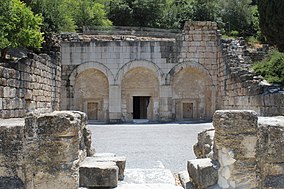| Beit She'arim National Park | |
|---|---|
 Facade of the "Cave of the Coffins" | |
| Location | Haifa District, Israel |
| Nearest city | Haifa |
| Coordinates | 32°42′8″N 35°7′37″E / 32.70222°N 35.12694°E |
| Governing body | Israel Nature and Parks Authority |
| Official name | Necropolis of Beit She'arim: A Landmark of Jewish Renewal |
| Type | Cultural |
| Criteria | ii, iii |
| Designated | 2015 (39th session) |
| Reference no. | 1471 |
| Region | Europe and North America |




Beit She'arim Necropolis (Hebrew: בֵּית שְׁעָרִים, "House of Gates") is an extensive rock-cut necropolis located near the ancient Jewish town of Beit She'arim,[1] 20 km east of Haifa in the southern foothills of the Lower Galilee. Part of Beit She'arim National Park, the site includes the necropolis and remains of the town. Used from the first to fourth centuries CE, its peak occurred in the late second century when the Sanhedrin, led by Patriarch Judah I, relocated to Beit She'arim, and his family was interred there.[2] In 2015, the necropolis was designated a UNESCO World Heritage Site.
The necropolis is carved out of soft limestone and contains more than 30 burial cave systems. When the catacombs were first explored by archaeologists in the 20th-century, the tombs had already fallen into great disrepair and neglect, and the sarcophagi contained therein had almost all been broken-into by grave robbers in search for treasure. This pillaging was believed to have happened in the 8th and 9th centuries CE based on the type of terra-cotta lamps found in situ.[3] The robbers also emptied the stone coffins of the bones of the deceased. During the Mamluk period (13–15th centuries), the "Cave of the Coffins" (Catacomb no. 20) served as a place of refuge for Arab shepherds.[4]
Lieutenant C. R. Conder of the Palestine Exploration Fund visited the site in late 1872 and described one of the systems of caves, known as "The Cave of Hell" (Mŭghâret el-Jehennum).[5] While exploring a catacomb, he found there a coin of Agrippa, which find led him to conclude that the ruins date back to "the later Jewish times, about the Christian era."[6] Benjamin Mazar, during his excavations of Sheikh Abreik, discovered coins that date no later than the time of Constantine the Great and Constantius II.[7]
Although only a portion of the necropolis has been excavated, it has been likened to a book inscribed in stone. Its catacombs, mausoleums, and sarcophagi are adorned with elaborate symbols and figures as well as an impressive quantity of incised and painted inscriptions in Hebrew, Aramaic, Palmyrene, and Greek, documenting two centuries of historical and cultural achievement. The wealth of artistic adornments contained in this, the most ancient extensive Jewish cemetery in the world, is unparalleled anywhere.[8][9]
- ^ Smallwood, E. Mary (1976). The Jews under Roman Rule. Studies in Judaism in Late Antiquity. Leiden, Netherlands: Brill. p. 120. ISBN 90-04-04491-4.
- ^ Smallwood, E. Mary (1976). The Jews under Roman Rule. Studies in Judaism in Late Antiquity. Leiden, Netherlands: Brill. p. 498. ISBN 90-04-04491-4.
- ^ Avigad (1958), p. 36.
- ^ Avigad (1958), p. 37.
- ^ Conder & Kitchener (1881), pp. 325 - ff.
- ^ Conder & Kitchener (1881), p. 351.
- ^ Mazar (1957), p. vi (Introduction).
- ^ Eichner, Itamar (2015). "Beit She'arim declared World Heritage Site". Ynetnews.
- ^ [1], UNESCO World Heritage Site,
